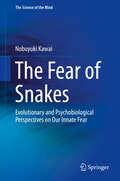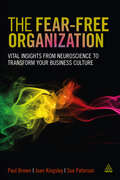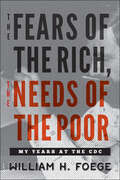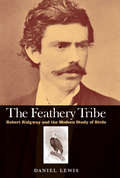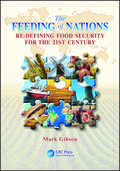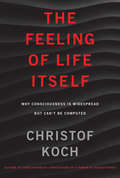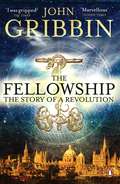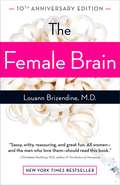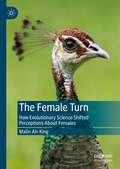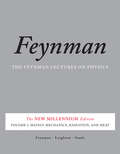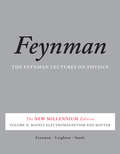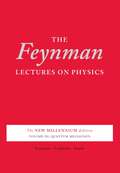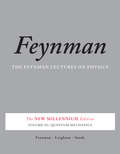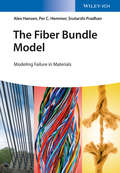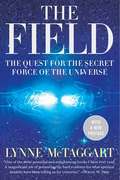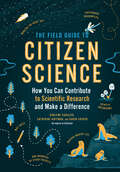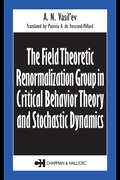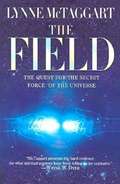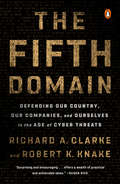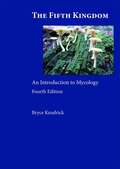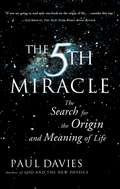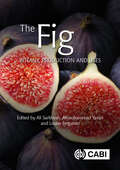- Table View
- List View
The Fear of Snakes: Evolutionary and Psychobiological Perspectives on Our Innate Fear (The Science of the Mind)
by Nobuyuki KawaiThis book provides a series of compelling evidence that shows that humans have innate fear of snakes. Building on the previous studies on the Snake Detection Theory (SDT), the author presents a summary of psychological and neuropsychological experiments to explain the fear of snakes in humans and primates. Readers will come to understand why and how we are afraid of snakes from an evolutionary perspective.The first half of the book discusses the history of psychological behaviorism and neobehaviorism. The latter half of the book consists mainly of the experimental studies performed by the author with a focus on three key items: First, compared with other animals, snakes especially draw the attention of primates and humans. Second, the ability of primates and humans to recognize snakes with particular efficiency. Third, processing mechanisms within the brain for snake detection is discussed from a new viewpointThe book offers a unique resource for all primatologists, psychologists, neuroscientists, anthropologists, herpetologists, and biologists who are interested in the evolution of visual and cognitive systems, mechanisms of fear, snakes or primates.
The Fear-free Organization
by Paul Brown Sue Paterson Joan KingsleyLeadership that makes a difference takes guts and confidence, plus belief in oneself and belief in the key players in the organization. It is built on trust, not fear. Scared people spend a lot more time plotting their survival than working productively, so The Fear- Free Organization has zero tolerance for bullies, vicious gossip, undermining behaviours, hijacking tactics, political jockeying for position or favouritism. Instead, it works on inspiration. Evidence from the new frontiers of neuroscience shows that individuals and organizations are more successful when people are encouraged to take risks, to explore new ideas, and to channel their energies in ways that work for them. The The Fear -Free Organization is a ground-breaking new book that reveals how our new understanding of the neurobiology of the self - how the brain constructs the person - can transform for the better the way our businesses and organizations work.
The Fears of the Rich, The Needs of the Poor: My Years at the CDC
by William W. FoegeWilliam H. Foege, one of the most respected leaders in global public health, takes readers on a tour of his time at the CDC.In its seventy years, the Centers for Disease Control and Prevention (CDC) has evolved from a malaria control program to an institution dedicated to improving health for all people across the world. The Fears of the Rich, The Needs of the Poor is a revealing account of the CDC’s development by its former director, public health luminary William H. Foege.Dr. Foege tells the stories of pivotal moments in public health, including the eradication of smallpox (made possible due in part to Foege’s research) and the discovery of Legionnaires’ disease, Reye syndrome, toxic shock syndrome, and HIV/AIDS. With good humor and optimism, he recounts the various crises he surmounted, from threats of terrorist attacks to contentious congressional hearings and funding cuts. Highlighting the people who made possible some of public health’s biggest successes, Foege outlines the work required behind the scenes and describes the occasional tensions between professionals in the field and the politicians in charge of oversight. In recent years, global public health initiatives have come from unanticipated sources. Giants in the field now include President Jimmy Carter and his wife, Rosalynn, who promote programs aimed at neglected diseases. Melinda and Bill Gates have invigorated the field through research and direct program support, especially in the area of vaccine-preventable diseases. And the Merck Mectizan program has dramatically reduced river blindness in Africa. Foege has been involved in all of these efforts, among others, and he brings to this book the knowledge and wisdom derived from a long and accomplished career. The Fears of the Rich, The Needs of the Poor is an inviting but unvarnished account of that career and offers a plethora of lessons for those interested in public health.
The Feathery Tribe
by Daniel LewisAmateurs and professionals studying birds at the end of the nineteenth century were a contentious, passionate group with goals that intersected, collided and occasionally merged in their writings and organizations. Driven by a desire to advance science, as well as by ego, pride, honor, insecurity, religion and other clashing sensibilities, they struggled to absorb the implications of evolution after Darwin. In the process, they dramatically reshaped the study of birds. Daniel Lewis here explores the professionalization of ornithology through one of its key figures: Robert Ridgway, the Smithsonian Institution’s first curator of birds and one of North America’s most important natural scientists. Exploring a world in which the uses of language, classification and accountability between amateurs and professionals played essential roles, Lewis offers a vivid introduction to Ridgway and shows how his work fundamentally influenced the direction of American and international ornithology. He explores the inner workings of the Smithsonian and the role of collectors working in the field and reveals previously unknown details of the ornithological journalThe Aukand the untold story of the color dictionaries for which Ridgway is known.
The Feeding of Nations: Redefining Food Security for the 21st Century
by Mark GibsonIn the last decade, the world has grown richer and produced more food than ever before. Yet in that same period, hunger has increased and 925 million remain underfed and malnourished. Exploring this troubling paradox, The Feeding of Nations: Re-Defining Food Security for the 21st Century offers a glimpse into how the simple aspiration of global foo
The Feeling of Life Itself: Why Consciousness Is Widespread but Can't Be Computed (The\mit Press Ser.)
by Christof KochAn argument that consciousness, more widespread than previously assumed, is the feeling of being alive, not a type of computation or a clever hack.In The Feeling of Life Itself, Christof Koch offers a straightforward definition of consciousness as any subjective experience, from the most mundane to the most exalted—the feeling of being alive. Psychologists study which cognitive operations underpin a given conscious perception. Neuroscientists track the neural correlates of consciousness in the brain, the organ of the mind. But why the brain and not, say, the liver? How can the brain, three pounds of highly excitable matter, a piece of furniture in the universe, subject to the same laws of physics as any other piece, give rise to subjective experience? Koch argues that what is needed to answer these questions is a quantitative theory that starts with experience and proceeds to the brain. In The Feeling of Life Itself, Koch outlines such a theory, based on integrated information.Koch describes how the theory explains many facts about the neurology of consciousness and how it has been used to build a clinically useful consciousness meter. The theory predicts that many, and perhaps all, animals experience the sights and sounds of life; consciousness is much more widespread than conventionally assumed. Contrary to received wisdom, however, Koch argues that programmable computers will not have consciousness. Even a perfect software model of the brain is not conscious. Its simulation is fake consciousness. Consciousness is not a special type of computation—it is not a clever hack. Consciousness is about being.
The Fellowship: The Story of a Revolution
by John GribbinFrom the bestselling author of Science: A History comes the enthralling story of a revolution that shook the world. Seventeenth-century England was racked by civil war, plague and fire; a world ruled by superstition and ignorance. A series of meetings of 'natural philosophers' in Oxford and London saw the beginning of a new method of thinking based on proof and experiment. John Gribbin's gripping, colourful account of this unparalleled time of discovery explores the impact of the Royal Society, culminating with Isaac Newton's revolutionary description of the universe and Edmund Halley's prediction of the return of a comet in 1759. This compelling book shows the triumph not as the work of one isolated genius, but of a Fellowship.
The Female Brain
by Louann BrizendineEvery brain begins as a female brain. It only becomes male eight weeks after conception, when excess testosterone shrinks the communications center, reduces the hearing cortex, and makes the part of the brain that processes sex twice as large. Louann Brizendine, M.D. is a pioneering neuropsychiatrist who brings together the latest findings to show how the unique structure of the female brain determines how women think, what they value, how they communicate, and whom they'll love. Brizendine reveals the neurological explanations behind why * A woman remembers fights that a man insists never happened * A teen girl is so obsessed with her looks and talking on the phone * Thoughts about sex enter a woman's brain once every couple of days but enter a man's brain about once every minute * A woman knows what people are feeling, while a man can't spot an emotion unless somebody cries or threatens bodily harm* A woman over 50 is more likely to initiate divorce than a manWomen will come away from this book knowing that they have a lean, mean communicating machine. Men will develop a serious case of brain envy.From the Hardcover edition.
The Female Brain (Conceptual Advances in Brain Research)
by Cynthia L. DarlingtonThe first edition of The Female Brain laid the groundwork for gaining a better understanding of the female brain, examining the evidence for structural and functional differences between the brains of males and females. Addressing a wealth of new research, the second edition continues in this vein, leading readers through the basic principles of an
The Female Turn: How Evolutionary Science Shifted Perceptions About Females
by Malin Ah-KingThis book traces the history of how evolutionary biology transformed its understanding of females from being coy, reserved and sexually passive, to having active sexual strategies and often mating with multiple males. Why did it take so long to discover female active sexual strategies? What prevented some researchers from engaging in sexually active females, and what prompted others to develop this new knowledge? The Female Turn provides a global overview of shifting perceptions about females in sexual selection research on a wide range of animals, from invertebrates to primates. Evolutionary biologist and feminist science scholar Malin Ah-King explores this history from a unique interdisciplinary vantage point. Based on extensive knowledge of the scientific literature on sexual selection and in-depth interviews with leading researchers, pioneers and feminist scientists in the field, her analysis engages with key theoretical approaches in gender studies of science. Analyzing the researchers’ scientific interests, theoretical frameworks, specific study animals, technological innovations, methodologies and sometimes feminist insights, reveals how these have shaped conclusions drawn about sex. Thereby, The Female Turn shows how certain researchers gained knowledge about active females whereas others missed, ignored or delayed it – that is, how ignorance was produced.
The Feynman Lectures on Physics, Vol. I: The New Millennium Edition: Mainly Mechanics, Radiation, and Heat
by Matthew Sands Robert B. Leighton Richard P. Feynman"The whole thing was basically an experiment,” Richard Feynman said late in his career, looking back on the origins of his lectures. The experiment turned out to be hugely successful, spawning publications that have remained definitive and introductory to physics for decades. Ranging from the basic principles of Newtonian physics through such formidable theories as general relativity and quantum mechanics, Feynman’s lectures stand as a monument of clear exposition and deep insight. Timeless and collectible, the lectures are essential reading, not just for students of physics but for anyone seeking an introduction to the field from the inimitable Feynman.
The Feynman Lectures on Physics, Vol. II: The New Millennium Edition: Mainly Electromagnetism and Matter
by Matthew Sands Robert B. Leighton Richard P. Feynman"The whole thing was basically an experiment," Richard Feynman said late in his career, looking back on the origins of his lectures. The experiment turned out to be hugely successful, spawning publications that have remained definitive and introductory to physics for decades. Ranging from the basic principles of Newtonian physics through such formidable theories as general relativity and quantum mechanics, Feynman's lectures stand as a monument of clear exposition and deep insight.Timeless and collectible, the lectures are essential reading, not just for students of physics but for anyone seeking an introduction to the field from the inimitable Feynman.
The Feynman Lectures on Physics, Vol. III: Quantum Mechanics
by Matthew Sands Robert B. Leighton Richard P. FeynmanThis revised edition of Feynman’s legendary lectures includes extensive corrections Feynman and his colleagues received and Caltech approved, making this the definitive edition of The Feynman Lectures on Physics. For all readers interested in physics.
The Feynman Lectures on Physics, Vol. III: The New Millennium Edition: Quantum Mechanics
by Matthew Sands Robert B. Leighton Richard P. Feynman"The whole thing was basically an experiment,” Richard Feynman said late in his career, looking back on the origins of his lectures. The experiment turned out to be hugely successful, spawning publications that have remained definitive and introductory to physics for decades. Ranging from the basic principles of Newtonian physics through such formidable theories as general relativity and quantum mechanics, Feynman’s lectures stand as a monument of clear exposition and deep insight. Timeless and collectible, the lectures are essential reading, not just for students of physics but for anyone seeking an introduction to the field from the inimitable Feynman.
The Fiber Bundle Model
by Srutarshi Pradhan Alex Hansen Per Christian HemmerGathering research from physics, mechanical engineering, and statistics in a single resource for the first time, this text presents the background to the model, its theoretical basis, and applications ranging from materials science to earth science. The authors start by explaining why disorder is important for fracture and then go on to introduce the fiber bundle model, backed by various different applications. Appendices present the necessary mathematical, computational and statistical background required. The structure of the book allows the reader to skip some material that is too specialized, making this topic accessible to the engineering, mechanics and materials science communities, in addition to providing further reading for graduate students in statistical physics.
The Field
by Lynne MctaggartScience has recently begun to prove what ancient myth and religion have always espoused: There may be such a thing as a life force. Lynne McTaggart, indefatigable investigative journalist, reveals a radical new biological paradigm -- that on our most fundamental level, the human mind and body are not distinct and separate from their environment but a packet of pulsating power constantly interacting with this vast energy sea. The Fieldis a highly readable scientific detective story that offers a stunning picture of an interconnected universe and a new scientific theory that makes sense of supernatural phenomena. Original, well researched, and well documented by distinguished sources,The Fieldis a book of hope and inspiration for today's world.
The Field Guide to Citizen Science: How You Can Contribute to Scientific Research and Make a Difference
by Caren Cooper Darlene Cavalier Catherine HoffmanLearn how monitoring the night sky, mapping trees, photographing dragonflies, and identifying mushrooms can help save the world! Citizen science is the public involvement in the discovery of new scientific knowledge. A citizen science project can involve one person or millions of people collaborating towards a common goal. It is an excellent option for anyone looking for ways to get involved and make a difference. The Field Guide to Citizen Science, from the expert team at SciStarter, provides everything you need to get started. You&’ll learn what citizen science is, how to succeed and stay motivated when you&’re participating in a project, and how the data is used. The fifty included projects, ranging from climate change to Alzheimer&’s disease, endangered species to space exploration, mean sure-fire matches for your interests and time. Join the citizen science brigade now, and start making a real difference!
The Field Theoretic Renormalization Group in Critical Behavior Theory and Stochastic Dynamics (Frontiers in Physics)
by A.N. Vasil'evThis volume provides a general field-theoretical picture of critical phenomena and stochastic dynamics and helps readers develop a practical skill for calculations. This education on the practical skill sets this book apart: it is the first to give a full technical introduction to the field. Both general ideas and ...hard... calculations are presen
The Field: The Quest for the Secret Force of the Universe
by Lynne MctaggartGreat book on new age metaphysics and the new science. McTaggart describes scientific discoveries that she believes point to a unifying concept of the universe, one that reconciles mind with matter, classic Newtonian science with quantum physics and, most importantly, science with religion. At issue is the zero point field, the so-called "dead space" of microscopic vibrations in outer space as well as within and between physical objects on earth. These fields, McTaggart asserts, are a "cobweb of energy exchange" that link everything in the universe; they control everything from cellular communication to the workings of the mind, and they could be harnessed for unlimited propulsion fuel, levitation, ESP, spiritual healing and more.
The Fifth Branch: Science Advisers as Policymakers
by Sheila JasanoffHow can decisionmakers charged with protecting the environment and the public's health and safety steer clear of false and misleading scientific research? Is it possible to give scientists a stronger voice in regulatory processes without yielding too much control over policy, and how can this be harmonized with democratic values? These are just some of the many controversial and timely questions that Sheila Jasanoff asks in this study of the way science advisers shape federal policy. In their expanding role as advisers, scientists have emerged as a formidable fifth branch of government. But even though the growing dependence of regulatory agencies on scientific and technical information has granted scientists a greater influence on public policy, opinions differ as to how those contributions should be balanced against other policy concerns. More important, who should define what counts as good science when all scientific claims incorporate social factors and are subject to negotiation? Jasanoff begins by describing some significant failures--such as nitrites, Love Canal, and alar--in administrative and judicial decisionmaking that fed the demand for more peer review of regulatory science. In analyzing the nature of scientific claims and methods used in policy decisions, she draws comparisons with the promises and limitations of peer review in scientific organizations operating outside the regulatory context. The discussion of advisory mechanisms draws on the author's close scrutiny of two highly visible federal agencies--the Environmental Protection Agency and the Food and Drug Administration. Here we see the experts in action as they deliberate on critical issues such as clean air, pesticide regulation, and the safety of pharmaceuticals and food additives. Jasanoff deftly merges legal and institutional analysis with social studies of science and presents a strong case for procedural reforms. In so doing, she articulates a social-construction model that is intended to buttress the effectiveness of the fifth branch.
The Fifth Domain: Defending Our Country, Our Companies, and Ourselves in the Age of Cyber Threats
by Richard A. Clarke Robert K. KnakeAn urgent new warning from two bestselling security experts--and a gripping inside look at how governments, firms, and ordinary citizens can confront and contain the tyrants, hackers, and criminals bent on turning the digital realm into a war zone. "In the battle raging between offense and defense in cyberspace, Clarke and Knake have some important ideas about how we can avoid cyberwar for our country, prevent cybercrime against our companies, and in doing so, reduce resentment, division, and instability at home and abroad."--Bill ClintonThere is much to fear in the dark corners of cyberspace. From well-covered stories like the Stuxnet attack which helped slow Iran's nuclear program, to lesser-known tales like EternalBlue, the 2017 cyber battle that closed hospitals in Britain and froze shipping crates in Germany in midair, we have entered an age in which online threats carry real-world consequences. But we do not have to let autocrats and criminals run amok in the digital realm. We now know a great deal about how to make cyberspace far less dangerous--and about how to defend our security, economy, democracy, and privacy from cyber attack. This is a book about the realm in which nobody should ever want to fight a war: the fifth domain, the Pentagon's term for cyberspace. Our guides are two of America's top cybersecurity experts, seasoned practitioners who are as familiar with the White House Situation Room as they are with Fortune 500 boardrooms. Richard A. Clarke and Robert K. Knake offer a vivid, engrossing tour of the often unfamiliar terrain of cyberspace, introducing us to the scientists, executives, and public servants who have learned through hard experience how government agencies and private firms can fend off cyber threats. Clarke and Knake take us inside quantum-computing labs racing to develop cyber superweapons; bring us into the boardrooms of the many firms that have been hacked and the few that have not; and walk us through the corridors of the U.S. intelligence community with officials working to defend America's elections from foreign malice. With a focus on solutions over scaremongering, they make a compelling case for "cyber resilience"--building systems that can resist most attacks, raising the costs on cyber criminals and the autocrats who often lurk behind them, and avoiding the trap of overreaction to digital attacks. Above all, Clarke and Knake show us how to keep the fifth domain a humming engine of economic growth and human progress by not giving in to those who would turn it into a wasteland of conflict. Backed by decades of high-level experience in the White House and the private sector, The Fifth Domain delivers a riveting, agenda-setting insider look at what works in the struggle to avoid cyberwar.
The Fifth Kingdom: An Introduction to Mycology
by Bryce KendrickThis new edition of The Fifth Kingdom has been updated to reflect the most recent developments in mycology, including the field's adoption of a new taxonomical framework for fungi as a whole, and the latest advances in molecular genetics. <p><p>The chapter on fungicides has been updated to include new discoveries. The discussion of poisonous mushrooms has been revised to include newly recognized types (and treatments) of mushroom poisoning. Chapters on medical aspects of mycology and practical uses for fungi have been expanded. Entirely new chapters—on applications of mycological training, among other topics—are all written with Kendrick's characteristic clarity, warmth, and humor—the qualities that have helped establish The Fifth Kingdom as one of the best, and most engaging, introductions to mycology.
The Fifth Man (Oxygen Series, #2)
by Randall Ingermanson John B. OlsonThe sequel to the award-winning Oxygen. Courage and self-sacrifice have finally brought the crew of Ares 10 safely to the planet Mars. They enthusiastically begin the mission they were sent to perform. Though working under dangerous conditions and experiencing strained relationships, the astronauts are encouraged by fascinating discoveries that seem to point to the presence of microscopic life on the planet. But their work is disrupted when frightening sabotage, like that of the trip to Mars, begins again. Is the "fifth man" alien or human? In this exciting sequel to Christie-award winning "Oxygen," high-stakes action, fascinating characters, and exciting romance will captivate both male and female readers.
The Fifth Miracle: The Search for the Origin and Meaning of Life (Penguin Press Science Ser.)
by Paul DaviesARE WE ALONE IN THE UNIVERSE?In his latest far-reaching book, The Fifth Miracle, internationally acclaimed physicist and writer Paul Davies confronts one of science's great outstanding mysteries -- the origin of life.Three and a half billion years ago, Mars resembled Earth. It was warm and wet and could have supported primitive organisms. If life once existed on Mars, might it have originated there and traveled to Earth inside meteorites blasted into space by cosmic impacts?Davies builds on the latest scientific discoveries and theories to address the larger question: What, exactly, is life? Is it the inevitable by-product of physical laws, as many scientists maintain, or an almost miraculous accident? Are we alone in the universe, or will life emerge on all Earth-like planets? And if there is life elsewhere in the universe, is it preordained to evolve toward greater complexity and intelligence?On the answers to these deep questions hinges the ultimate purpose of mankind -- who we are and what our place might be in the unfolding drama of the cosmos.
The Fig: Botany, Production and Uses (Botany, Production and Uses)
by Patrick Brown Zhihong Li Yue Zhang Dr Ioannis Tzanetakis Giuseppe Massimino Cocuzza Professor Jose Ignacio Hormaza Giancarlo Colelli Louise Ferguson Margarita López Corrales Manuel Joaquín Serradilla Sánchez Giuseppe Ferrara Andrea Mazzeo Diganta Narzary Zeinab Shokoohi Federica Spagnoli Alimohammad Yavari Simon Van Noort Mohammad Abdolahipour Fateh Aljane Azam Amiri Maria L Amodio Francisco C Balas Zeinab Bolboli Anshul Chawla Pasqualina Colasuonno Neda Dalir Naser Davatgar Birgül Ertan Engin Ertan Badii Gaaliche Ana I Galván A. J Galán Carlos A. Garza Jan H. Giliomee Phoebe Gordon Matthew J. Grieshop G Dalkiliç Günver Akihiro Hosomi Hidetoshi Ikegami Ali Akbar Kamgar-Haghighi Finn Kjellberg Moslem Jafari Mahshad Maghoumi Chabane Mazri Themis J. Michailides Reza Mostowfizadeh-Ghalamfarsa Mohamed H Neily Hitoshi Nogata Professor A Aytekin Polat Asghar Ramezanian Jean-Yves Rasplus Maria G.F. Rodrigues Sead Sabanadzovic Rajwinder K. Sandhu Vassilio Stournaras Mohammad H. Tarazkar Hiroshi Yakushiji Megan Crivelli Tatjana K Kokaj Souhila Mahmoudi Ilaria MarcotuliThe common fig Ficus carica L. is an ancient fruit native to the Mediterranean. Dried figs have been successfully produced and processed in arid regions with little sophisticated infrastructure for centuries. Figs are rich in fibre, trace minerals, polyphenols and vitamins, with higher nutrient levels than most fruits. Advances in agricultural production and postharvest technologies have not only improved the efficiency of dried fig production but have facilitated the development of high value fresh fig industries both for export and domestic markets. The result is high quality fresh figs that are marketed internationally throughout the year. This book provides a comprehensive summary of fig growing, processing and marketing from a scientific and horticultural perspective. It is comprised of 19 chapters that include in-depth discussions of: History of fig cultivation; Physiology; Breeding and cultivars; Propagation; Site selection and orchard establishment; Nutrition and irrigation management; Pollination management; Integrated pest management; Greenhouse production; Harvesting, dried and fresh fig processing; The medicinal uses of figs; and World fig markets. The Fig: Botany, Production and Uses is a comprehensive applied resource for academic researchers, as well as producers, processors, and marketers of dried and fresh figs.
